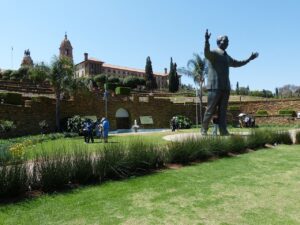[imagesource:here]
Never has the saying “lies, damn lies, and statistics” been more apt.
Facebook is full of armchair virus experts, talking about how the curve is/isn’t flattening, the lockdown is/isn’t working, and our economy will/will never recover, whilst sharing statistics that come from some less than trustworthy sources.
Don’t get me started on the 5G morons – they long since gave up on rational thought.
Depending on which statistics you believe, your argument is bolstered, and you can get back to the important thing, which seems to be arguing with strangers on the internet.
When looking at South Africa’s early response (characterised by the BBC as “ruthlessly efficient”), and using the Johns Hopkins University data, which is universally recognised as one of the most reliable resources, we can compare the effectiveness of the measures thus far.
Writing for the Daily Maverick, Marcus Hollington, a research director at Focal Africa Research, and Monique Bennett, a data scientist at Good Governance Africa, have done just that.
Their conclusion? We have been “world-class”:
In contrast to the rest of the world, South Africa’s efforts to flatten the curve have been nothing short of world-class coming in second to Algeria, attesting to the advantage of implementing physical distancing and lockdown measures in a timely manner to curb the spread of Covid-19…

According to the graph [above], Australia ranked third, Japan ranked fourth and Russia ranked fifth. The public health measures implemented by these countries have been tremendously successful thus far in flattening the curve, though Russia has not yet achieved the aforementioned as it continues to experience an upward though controllable trend in its trajectory.
Using the stats available on April 13, our case fatality rate of 1,19% is better than the likes of Cameroon, Morocco, Egypt and Algeria, despite the fact that we are dealing with more cases than all of those countries.
Hollington and Bennett then talk about what is perhaps “the most important indicator in assessing South Africa’s approach to the pandemic”, which is our active cases:
The graph shows that while the number of “confirmed cases” has been increasing in South Africa (currently 2,272 cases), so has the fight by health workers to reduce these numbers by treating those infected as depicted by the active cases (currently 1,835 cases), in the graph.

The latter provides a more accurate depiction of the country’s Covid-19 situation and the efficiency of its measures in response to confirmed cases. It does this by removing the total number of recoveries and deaths from the cumulative number of confirmed Covid-19 cases, which are currently 410 and 27 respectively as they no longer constitute as positive Covid-19 cases.
The government’s response to the pandemic hasn’t been without criticism, and one of the most commonly raised issues is the slow rollout of tests across the country.
Using the Worldometer stats (correct as of 8AM on Wednesday, April 15), the US conducts 9 376 tests per million citizens, Spain 12 833, Italy 17 758, France 5 114, Germany 15 370, and the UK 5 637.
Those are currently the six countries with the most confirmed coronavirus cases.
South Africa, however, has conducted just 1 467 tests per million citizens, which is clearly going to result in a lower number of confirmed cases.
That number is on the rise, though:
Although we are still below the target of 10,000 tests per day, overall testing in communities has gradually increased and we are currently on an average of 5,678 tests per day. Professor Salim Abdool Karim, Chairperson of the Covid-19 Ministerial Advisory Committee, advised South Africans on why the lockdown will assist the healthcare system to prepare for what will be an inevitable rise in cases.

Since the lockdown, 28,000 community healthcare workers have been deployed in vulnerable communities to screen and test individuals. “Active” case findings are vital if we are to identify where the community transmission is taking place. This allows the government to intervene before community transmission takes place. A similar strategy was conducted in South Korea (Trace, Test and Treat), which helped flatten their curve.
The difference is South Africa’s lockdown came much earlier and has bought the healthcare system some valuable time to prepare hospitals, staff and community clinics for a worst-case scenario.
Therein lies the real point of why we called our lockdown early, and why we are now being asked to stay indoors for a further two weeks on top of the original 21 days.
Our efforts now are buying invaluable time for what is to come, and if the healthcare systems of countries like Italy, Spain, the US and the UK can be overrun, we need all the preparation time we can get.
After all, you only know when something like a lockdown is a success when people in years to come look back and think you overreacted.
[source:dailymaverick]





